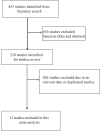Plasma 25-hydroxyvitamin D levels, vitamin D intake, and pancreatic cancer risk or mortality: a meta-analysis
- PMID: 28969079
- PMCID: PMC5610011
- DOI: 10.18632/oncotarget.18888
Plasma 25-hydroxyvitamin D levels, vitamin D intake, and pancreatic cancer risk or mortality: a meta-analysis
Abstract
Background: The associations between vitamin D status, including plasma 25-hydroxyvitamin D [25(OH)D] levels and vitamin D intake, and pancreatic cancer risk and mortality are inconsistent. The aims of this study are to evaluate the antitumor and therapeutic effects of vitamin D status for pancreatic cancer patients.
Methods: A literature search for relevant studies was conducted using PubMed and Embase databases. Risk ratio (RR), hazard ratio (HR), and 95% confidence interval (CI) were used as the effect measures. All statistical analyses were performed using Stata software 12.0.
Results: Our results indicated that high plasma 25(OH)D levels were inversely associated with pancreatic cancer mortality without significant heterogeneity (HR=0.81, 95% CI=0.68-0.96). However, high plasma 25(OH)D levels could not reduce pancreatic cancer risk (RR=1.02, 95% CI=0.66-1.57). Moreover, vitamin D intake was also not associated with pancreatic cancer risk (RR=1.11, 95% CI=0.67-1.86).
Conclusions: Our results indicate that high plasma 25(OH)D levels were significantly associated with improved survival in pancreatic cancer patients. However, there were no significant associations between vitamin D intake or plasma 25(OH)D levels and pancreatic cancer risk.
Keywords: 25-hydroxyvitamin D; mortality; pancreatic cancer; risk; vitamin D.
Conflict of interest statement
CONFLICTS OF INTEREST All authors declare that they have no competing interests.
Figures





Similar articles
-
Vitamin D Intake, Serum 25-Hydroxyvitamin-D (25(OH)D) Levels, and Cancer Risk: A Comprehensive Meta-Meta-Analysis Including Meta-Analyses of Randomized Controlled Trials and Observational Epidemiological Studies.Nutrients. 2023 Jun 12;15(12):2722. doi: 10.3390/nu15122722. Nutrients. 2023. PMID: 37375626 Free PMC article.
-
Additively protective effects of vitamin D and calcium against colorectal adenoma incidence, malignant transformation and progression: A systematic review and meta-analysis.Clin Nutr. 2020 Aug;39(8):2525-2538. doi: 10.1016/j.clnu.2019.11.012. Epub 2019 Nov 16. Clin Nutr. 2020. PMID: 31784301
-
Associations of the risk of lung cancer with serum 25-hydroxyvitamin D level and dietary vitamin D intake: A dose-response PRISMA meta-analysis.Medicine (Baltimore). 2018 Sep;97(37):e12282. doi: 10.1097/MD.0000000000012282. Medicine (Baltimore). 2018. PMID: 30212966 Free PMC article. Review.
-
Vitamin D status and the risk of pancreatic cancer: a meta-analysis.Chin Med J (Engl). 2013;126(17):3356-9. Chin Med J (Engl). 2013. PMID: 24033964
-
Plasma Vitamin D Level and Change in Albuminuria and eGFR According to Sodium Intake.Clin J Am Soc Nephrol. 2015 Dec 7;10(12):2119-27. doi: 10.2215/CJN.03830415. Epub 2015 Oct 8. Clin J Am Soc Nephrol. 2015. PMID: 26450935 Free PMC article.
Cited by
-
Serum 25-Hydroxyvitamin D Levels and Survival Outcomes in Advanced Biliary Tract Cancer: Results From the NIFTY Trial.Cancer Med. 2025 Jan;14(1):e70560. doi: 10.1002/cam4.70560. Cancer Med. 2025. PMID: 39749730 Free PMC article.
-
Vitamin D and Multiple Health Outcomes: An Umbrella Review of Observational Studies, Randomized Controlled Trials, and Mendelian Randomization Studies.Adv Nutr. 2022 Aug 1;13(4):1044-1062. doi: 10.1093/advances/nmab142. Adv Nutr. 2022. PMID: 34999745 Free PMC article.
-
Vitamin D in Cancer Prevention: Gaps in Current Knowledge and Room for Hope.Nutrients. 2022 Oct 27;14(21):4512. doi: 10.3390/nu14214512. Nutrients. 2022. PMID: 36364774 Free PMC article. Review.
-
Vitamin D Intake, Serum 25-Hydroxyvitamin-D (25(OH)D) Levels, and Cancer Risk: A Comprehensive Meta-Meta-Analysis Including Meta-Analyses of Randomized Controlled Trials and Observational Epidemiological Studies.Nutrients. 2023 Jun 12;15(12):2722. doi: 10.3390/nu15122722. Nutrients. 2023. PMID: 37375626 Free PMC article.
-
Umbrella Review on the Relationship between Vitamin D Levels and Cancer.Nutrients. 2024 Aug 15;16(16):2720. doi: 10.3390/nu16162720. Nutrients. 2024. PMID: 39203855 Free PMC article.
References
-
- Torre LA, Bray F, Siegel RL, Ferlay J, Lortet-Tieulent J, Jemal A. Global cancer statistics, 2012. CA Cancer J Clin. 2015;65:87–108. - PubMed
-
- Siegel RL, Miller KD, Jemal A. Cancer statistics, 2017. CA Cancer J Clin. 2017;67:7–30. - PubMed
-
- Kamisawa T, Wood LD, Itoi T, Takaori K. Pancreatic cancer. Lancet. 2016;388:73–85. - PubMed
-
- Rosen CJ. Clinical practice. Vitamin D insufficiency. N Engl J Med. 2011;364:248–254. - PubMed
LinkOut - more resources
Full Text Sources
Other Literature Sources

